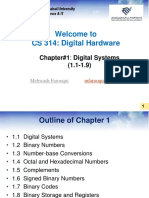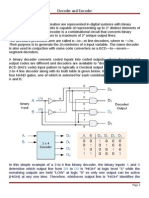IT Era Midterm Reviewer
Uploaded by
Jefferson DiazIT Era Midterm Reviewer
Uploaded by
Jefferson DiazI.
Number Systems Overview
1. Decimal System (Base 10)
o The most commonly used number system.
o Uses digits 0–9.
o Example: 15210152_{10}15210
2. Binary System (Base 2)
o Used in digital computing.
o Uses only two digits: 0 and 1.
o Example: 110121101_211012
o Key Rule: Each place value represents powers of 2.
o Converting Decimal to Binary: Divide the decimal number by 2, record the
remainders, and reverse the order.
3. Octal System (Base 8)
o Uses digits 0–7.
o Example: 57857_8578
o Converting Binary to Octal: Group binary digits in sets of 3 (starting from the right)
and convert each group to octal.
o Converting Decimal to Octal: Divide by 8 and record the remainders.
4. Hexadecimal System (Base 16)
o Uses digits 0–9 and letters A–F (where A=10, B=11, ..., F=15).
o Example: A316A3_{16}A316
o Converting Binary to Hexadecimal: Group binary digits in sets of 4 and convert
each group to hexadecimal.
o Converting Decimal to Hexadecimal: Divide by 16 and record the remainders.
II. Conversions Between Number Systems
1. Binary to Decimal Conversion
Multiply each binary digit by 2 raised to the power of its position (starting from 0 at the right),
then sum the results.
Example:
10112=(1×23)+(0×22)+(1×21)+(1×20)=11101011_2 = (1 \times 2^3) + (0 \times 2^2) + (1
\times 2^1) + (1 \times 2^0) = 11_{10}10112=(1×23)+(0×22)+(1×21)+(1×20)=1110
2. Decimal to Binary Conversion
Continuously divide the decimal number by 2, noting the remainders, and reverse the order
of remainders.
Example:
4310=101011243_{10} = 101011_24310=1010112
3. Binary to Octal Conversion
Group binary digits in sets of 3 (from right to left) and convert each group to the equivalent
octal digit.
Example:
1010112=(101)(011)=538101011_2 = (101)(011) = 53_81010112=(101)(011)=538
4. Octal to Binary Conversion
Convert each octal digit to its 3-bit binary equivalent.
Example:
538=101011253_8 = 101011_2538=1010112
5. Binary to Hexadecimal Conversion
Group binary digits in sets of 4 (from right to left) and convert each group to the equivalent
hexadecimal digit.
Example:
110101012=(1101)(0101)=D51611010101_2 = (1101)(0101) = D5_{16}110101012
=(1101)(0101)=D516
6. Hexadecimal to Binary Conversion
Convert each hexadecimal digit to its 4-bit binary equivalent.
Example:
3A16=0011101023A_{16} = 00111010_23A16=001110102
7. Decimal to Octal Conversion
Continuously divide the decimal number by 8 and record the remainders.
Example:
7810=116878_{10} = 116_87810=1168
8. Decimal to Hexadecimal Conversion
Continuously divide the decimal number by 16 and record the remainders.
Example:
25510=FF16255_{10} = FF_{16}25510=FF16
9. Hexadecimal to Decimal Conversion
Multiply each hexadecimal digit by 16 raised to the power of its position, then sum the
results.
Example:
A316=(10×161)+(3×160)=16310A3_{16} = (10 \times 16^1) + (3 \times 16^0) = 163_{10}A316
=(10×161)+(3×160)=16310
III. Key Binary and Hexadecimal Equivalents
Decimal Binary Hexadecimal
0 0000 0
1 0001 1
2 0010 2
3 0011 3
4 0100 4
5 0101 5
6 0110 6
7 0111 7
8 1000 8
9 1001 9
10 1010 A
11 1011 B
12 1100 C
13 1101 D
14 1110 E
15 1111 F
IV. Example Problems
1. Convert 78 to binary:
o Divide by 2 and collect remainders:
78÷2=3978 \div 2 = 3978÷2=39 remainder 0
39÷2=1939 \div 2 = 1939÷2=19 remainder 1
19÷2=919 \div 2 = 919÷2=9 remainder 1
9÷2=49 \div 2 = 49÷2=4 remainder 1
4÷2=24 \div 2 = 24÷2=2 remainder 0
2÷2=12 \div 2 = 12÷2=1 remainder 0
1÷2=01 \div 2 = 01÷2=0 remainder 1
o Answer: 100111021001110_210011102
2. Convert 1101 (binary) to decimal:
o Use the binary weights:
(1×23)+(1×22)+(0×21)+(1×20)(1 \times 2^3) + (1 \times 2^2) + (0 \times 2^1) + (1
\times 2^0)(1×23)+(1×22)+(0×21)+(1×20)
=8+4+0+1=13= 8 + 4 + 0 + 1 = 13=8+4+0+1=13
o Answer: 131013_{10}1310
3. Convert 9A (hexadecimal) to binary:
o 9 = 100121001_210012, A = 101021010_210102
o Answer: 10011010210011010_2100110102
4. Convert 255 (decimal) to hexadecimal:
o Divide by 16:
255÷16=15255 \div 16 = 15255÷16=15 remainder 15 (F in hexadecimal)
15÷16=015 \div 16 = 015÷16=0 remainder 15 (F in hexadecimal)
o Answer: FF16FF_{16}FF16
5. Convert 53 (octal) to decimal:
o Multiply each octal digit by the corresponding power of 8:
(5×81)+(3×80)=40+3=43(5 \times 8^1) + (3 \times 8^0) = 40 + 3 =
43(5×81)+(3×80)=40+3=43
o Answer: 431043_{10}4310
You might also like
- Chapter 1 Digital Systems and Binary NumbersNo ratings yetChapter 1 Digital Systems and Binary Numbers88 pages
- Number Systems: Location in Course TextbookNo ratings yetNumber Systems: Location in Course Textbook59 pages
- @Lecture-COAL: Course Instructor: Khawaja Ubaid Ur Rehman Section: V3/V4/V5 SSTNo ratings yet@Lecture-COAL: Course Instructor: Khawaja Ubaid Ur Rehman Section: V3/V4/V5 SST81 pages
- Chapter 1 Digital Systems and Binary NumbersNo ratings yetChapter 1 Digital Systems and Binary Numbers100 pages
- CHAPTER 3 Data Representation and Computer Arithmetic100% (1)CHAPTER 3 Data Representation and Computer Arithmetic12 pages
- Module 1: Computer Fundamentals 1.1 Introduction To Number System and CodesNo ratings yetModule 1: Computer Fundamentals 1.1 Introduction To Number System and Codes45 pages
- Digital Logic & Computer Organization and ArchitectureNo ratings yetDigital Logic & Computer Organization and Architecture39 pages
- Course Name: Digital Electronics Course Code: U18Esec303 Topic: Number SystemsNo ratings yetCourse Name: Digital Electronics Course Code: U18Esec303 Topic: Number Systems36 pages
- MOD 2 - Data Representation and Number SystemNo ratings yetMOD 2 - Data Representation and Number System52 pages
- NUMBER SYSTEM _DIGITAL FUNDAMENTAL AND COMPUTER ARCHITECTURENo ratings yetNUMBER SYSTEM _DIGITAL FUNDAMENTAL AND COMPUTER ARCHITECTURE90 pages
- Numbersystem 150506052854 Conversion Gate02No ratings yetNumbersystem 150506052854 Conversion Gate0243 pages
- CHAPTER 1 Data Representation in ComputersNo ratings yetCHAPTER 1 Data Representation in Computers16 pages
- Digital Logic Fundamentals Notes Unit 1 and 2No ratings yetDigital Logic Fundamentals Notes Unit 1 and 225 pages
- Digital Logic Design: Sessional Marks:40 End Exam: 3 Hours End Exam Marks:60No ratings yetDigital Logic Design: Sessional Marks:40 End Exam: 3 Hours End Exam Marks:602 pages
- OBE Computer Application in Business - Md. Monowar Uddin TalukdarNo ratings yetOBE Computer Application in Business - Md. Monowar Uddin Talukdar9 pages
- Chapter 1 - Data Representation 1.1 - Data TypesNo ratings yetChapter 1 - Data Representation 1.1 - Data Types12 pages
- Introduction To Computers 1.1 History of ComputersNo ratings yetIntroduction To Computers 1.1 History of Computers132 pages
- Solution: Homework #1 Chapter 1 Basic ConceptsNo ratings yetSolution: Homework #1 Chapter 1 Basic Concepts3 pages
- @Lecture-COAL: Course Instructor: Khawaja Ubaid Ur Rehman Section: V3/V4/V5 SST@Lecture-COAL: Course Instructor: Khawaja Ubaid Ur Rehman Section: V3/V4/V5 SST
- CHAPTER 3 Data Representation and Computer ArithmeticCHAPTER 3 Data Representation and Computer Arithmetic
- Module 1: Computer Fundamentals 1.1 Introduction To Number System and CodesModule 1: Computer Fundamentals 1.1 Introduction To Number System and Codes
- Digital Logic & Computer Organization and ArchitectureDigital Logic & Computer Organization and Architecture
- Course Name: Digital Electronics Course Code: U18Esec303 Topic: Number SystemsCourse Name: Digital Electronics Course Code: U18Esec303 Topic: Number Systems
- NUMBER SYSTEM _DIGITAL FUNDAMENTAL AND COMPUTER ARCHITECTURENUMBER SYSTEM _DIGITAL FUNDAMENTAL AND COMPUTER ARCHITECTURE
- Basic Mathematics. Explained Easy | For BeginnersFrom EverandBasic Mathematics. Explained Easy | For Beginners
- Digital Logic Design: Sessional Marks:40 End Exam: 3 Hours End Exam Marks:60Digital Logic Design: Sessional Marks:40 End Exam: 3 Hours End Exam Marks:60
- OBE Computer Application in Business - Md. Monowar Uddin TalukdarOBE Computer Application in Business - Md. Monowar Uddin Talukdar
- Introduction To Computers 1.1 History of ComputersIntroduction To Computers 1.1 History of Computers

























































































